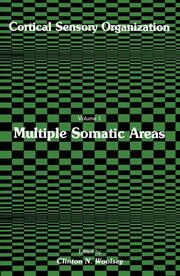Detailansicht
Cortical Sensory Organization
Multiple Somatic Areas, Cortical Sensory Organization 1
ISBN/EAN: 9781461258131
Umbreit-Nr.: 5657587
Sprache:
Englisch
Umfang: xvi, 245 S.
Format in cm:
Einband:
kartoniertes Buch
Erschienen am 17.10.2011
Auflage: 1/2011
€ 160,49
(inklusive MwSt.)
Nachfragen
- Zusatztext
- In April 1979 a symposium on "Multiple Somatic Sensory Motor, Visual and Auditory Areas and Their Connectivities" was held at the FASEB meeting in Dallas, Texas. The papers presented at that symposium are the basis of most of the substantially augmented, updated chapters in the three volumes of Cortical Sensory Organi zation. Only the material in chapter 8 of volume 3 was not pre sented in one form or another at that meeting. The aim of the symposium was to review the present status of the field of cortical representation in the somatosensory, visual and auditory systems. Since the early 1940s, the number of recognized cortical areas related to each of these systems has been increasing until at present the number of visually related areas exceeds a dozen. Although the number is less for the somatic and auditory systems, these also are more numerous than they were earlier and are likely to increase still further since we may expect each system to have essentially the same number of areas related to it.
- Autorenportrait
- Inhaltsangabe1 The Somatic Sensory Cortex: Sm I in Prosimian Primates.- 1. Comparative Study of Primates.- 2. Comparative Significance of Sulcal Patterns in Sensorimotor Cortex of Primates.- 2.1. Living and Extinct Prosimians.- 2.2. Old and New World Simians.- 3. Comparative Significance of Physiological Organization and Cytoarchitectonic Fields of Sm I in Primates.- 3.1. Rationale for Galago Studies.- 3.2. Intrinsic Organization of Sm I in Galago.- 3.3. Homologs of Sm I in Prosimian and Simian Primates.- 4. Multiple Sm I Areas and Behavior.- 5. Summary.- Acknowledgments.- References.- 2 The Postcentral Somatosensory Cortex: Multiple Representations of the Body in Primates.- 1. Introduction.- 2. Features of Organization of the Two Representations of the Skin in Monkeys.- 2.1. Features of the Cutaneous Representations Common to Different Species.- 2.2. Species Differences in the Area 3b and the Area 1 Representations.- 3. Evidence That the Area 3b Representation of Monkeys is Homologous with S I of Other Mammals.- 4. Significance of Continuities and Discontinuities in Cutaneous Representations.- 5. Summary.- References.- 3 Organization of the SI Cortex: Multiple Cutaneous Representations in Areas 3b and 1 of the Owl Monkey.- 1. Introduction.- 2. Basic Approach.- 2.1. Experimental Strategy.- 2.2. A Note on Terminology.- 3. Summary of Results.- 3.1. Internal Organization of Parietal Somatosensory Strip (PSS) Cutaneous Fields.- 3.2. Some Implications.- 3.3. Further Studies on the Internal Organization of "S I" Fields.- 4. Evidence for Functional "Modules" within "S I".- 5. Dynamic Features of Cortical Field Organization.- Acknowledgments.- References.- 4 Organization of the S II Parietal Cortex: Multiple Somatic Sensory Representations within and near the Second Somatic Sensory Area of Cynomolgus Monkeys.- I. Introduction.- 2. Methods and Procedures.- 3. Results.- 3.1. The Location of S II.- 3.2. Receptive Fields in S II.- 3.3. Organization of the Body in S II.- 3.4. The S II Complex Zones.- 3.5. The Location of Area 7 Posterior to S II.- 3.6. Somatic Receptive Fields in Area 7b.- 3.7. Somatotopic Organization with in 7b.- 3.8. The Location of the Retroinsular Area, Postauditory Area and Granular Insula.- 3.9. Receptive Fields of Neurons within Ri and Pa.- 3.10. Possible Somatotopography Along the Fundal Region of the Lateral Sulcus.- 3.11. Somatic Sensory Activation of Granular Insular Neurons.- 3.12. Distribution of Somatic Submodalities.- 4. Discussion.- 4.1. Interpretations of Area 7 Function.- 4.2. Thalamocortical Connections to Area 7.- 4.3. The Retroinsular and Postauditory Cortical Areas.- Acknowledgments.- Abbreviations.- References.- 5 Body Topography in the Second Somatic Sensory Area: Monkey S II Somatotopy.- 1. Introduction.- 2. Methods.- 3. Results.- 3.1. The Cytoarchitecture of S II.- 3.2. Patterns of Axonal and Cellular Labeling.- 3.3. The Topology of the Body Representation in S II.- 3.4. The Retroinsular Area.- 4. Discussion.- 4.1. Reconstruction of the Lateral Sulcus.- 4.2. The Body Representation.- 4.3. Patterns of Cellular and Axonal Distribution in S II.- 4.4. Some Functional Considerations.- Acknowledgements.- Abbreviations.- References.- 6 Supplementary Sensory Area: The Medial Parietal Cortex in the Monkey.- 1. Introduction.- 2. Organization of Corticospinal Neurons in the Posterior Parietal Cortex.- 2.1. Experimental Design and Procedure.- 2.2. Projections to the Upper Cervical Cord.- 2.3. Cervical Enlargement Projections.- 2.4. Cortical Projections to the Lumbosacral Cord.- 2.5. Somatotopic Organization of Corticospinal Neurons in the Posterior Parietal Cortex.- 2.6. Proportion of the Corticospinal Tract Emanating from the Posterior Parietal Cortex.- 3. Response Properties of Neurons in the Medial Posterior Parietal Cortex.- 3.1. Experimental Design and Procedure.- 3.2. Receptive Fields of Neurons in the Medial Posterior Parietal Cortex.- 3.3. Response Properties of Neurons in the Medial Posterior Parietal Cortex.- 4
